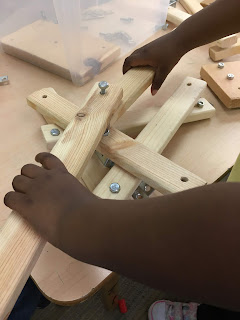It’s
sometimes hard to know when to talk to a child who is deeply engaged in an activity,
and it’s hard to know what to say. We’ve been trained as teachers to ask questions,
comment, narrate, and reflect. There are times when the right question at the
right time can extend a child’s thinking and provide the spark for the next
phase of their activity.
There are other times when talking just gets in the way of what they’re doing.
Even as we say that “children learn through play” and that we value “process over product” so much of teacher speech interrupts the child’s process and trying to lead the child to a tangible product. Often when a teacher says, “Tell me about what you’re doing” or “What’s your plan?”, it’s less about meeting the child where they are in the moment, and more about the teacher wanting information for themselves. Or just wanting to connect with the child who is at play, which is a wonderful goal, but requiring children who are immersed in process to answer adult questions isn’t always the best way to connect.
There are other times when talking just gets in the way of what they’re doing.
Even as we say that “children learn through play” and that we value “process over product” so much of teacher speech interrupts the child’s process and trying to lead the child to a tangible product. Often when a teacher says, “Tell me about what you’re doing” or “What’s your plan?”, it’s less about meeting the child where they are in the moment, and more about the teacher wanting information for themselves. Or just wanting to connect with the child who is at play, which is a wonderful goal, but requiring children who are immersed in process to answer adult questions isn’t always the best way to connect.
I
watched while one of the three-year-olds explored wood pieces and nuts and
bolts. The wood pieces had holes drilled in them, with the intention that children
would discover how to fit a bolt inside, and how to connect two or more pieces
with a single bolt. She worked lining up the pieces, examining the shapes they
were making. She put two pieces over each other, the holes lining up almost
exactly.
“I wonder what would fit inside those holes?” I asked.
She completely ignored me, and I felt a sense of discontent, that I had encroached on her process. The bolts were right there – she had been using them a moment before. If she wanted to put a bolt in the hole, she would have. She didn’t need me to tell her how to do it. Prompting her to “fit something” inside the holes was about me and my need to “teach” – not about her need to explore the materials through her own process.
Later, she put in a bolt, but didn’t push it down to connect the pieces. This time, I stayed silent, and allowed her to experience the process her way, without my interruptions.
Eventually, after putting together many pieces, moving them around, and taking some apart, she announced, “It’s a clock!”
and showed me how two of the wooden pieces moved like hands. She added small
metal pieces and said they were the numbers. After observing her entire
process, I don’t think she had a “plan” to build a clock, or to build anything.
For young children, the representational “product” often comes at the end of
the process. After completing the process of building, or drawing, or painting,
the child decides what their creation looks like, and labels it. The true
learning takes place in the process, and through the play of getting there. Sometimes
there are questions or comments adults have that can help them in their process,
but often, we just need to get out of the way.
Eventually, after putting together many pieces, moving them around, and taking some apart, she announced, “It’s a clock!” and showed me how two of the wooden pieces moved like hands. She added small metal pieces and said they were the numbers. After observing her entire process, I don’t think she had a “plan” to build a clock, or to build anything. For young children, the representational “product” often comes at the end of the process. After completing the process of building, or drawing, or painting, the child decides what their creation looks like, and labels it. The true learning takes place in the process, and through the play of getting there. Sometimes there are questions or comments adults have that can help them in their process, but often, we just need to get out of the way.



